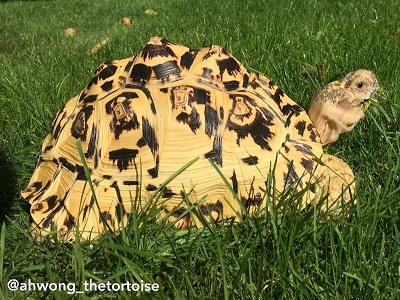
With the celebration of World Turtle Day every May 23rd, we have dedicated every Animal of the Month for May to a turtle or tortoise and this May was no exception. But now that June is around the corner, it is time for us to say goodbye to the leopard tortoise as our Animal of the Month for May 2020. We hope you spent some time with us on Twitter @ExoticPetVets as we tweeted all month long about the leopard tortoise. Here is a summary in case you missed any of our tweets. Did you know?:
- The leopard tortoise (Stigmochelys pardalis) is endemic to Africa and has a large range stretching from the eastern part of the continent to the south.
- The first part of the leopard tortoise’s scientific name “Stigmochelys” combines the Greek words stigma (which means “marked”) and “chelone” (which means “tortoise”). The pardalis part of the name comes from the Greek word for “spotted.”
- The leopard tortoise is the second-largest tortoise species in all of Africa – only the sulcata tortoise (also known as the African spurred tortoise) is bigger.
- Leopard tortoises can live as long as 100 years in the wild. Because they are such a long-lived species, their lifespan in captivity under optimal care conditions could exceed that, but is currently unknown.
- Leopard tortoises can be found in a variety of habitats in the wild, but for the most part they live in the savannahs of Africa as they do not tolerate cold or damp conditions.
- In the wild, the leopard tortoise is also found in scrub and grasslands. They can also be found in areas where the elevations of up to 2,900 metres above sea level, which can explain why they are also known as the mountain tortoise.
- In terms of the leopard tortoise home range, it can vary widely depending on food and shelter availability.
- Female leopard tortoises also tend to have larger home ranges than males because they need to find extra resources in order to help them produce eggs. Female leopard tortoises also need to find safe places to lay their eggs.
- Adult leopard tortoises are quite large when fully grown, reaching lengths of up to 1.5 feet (46 cms). They usually weigh about 40 pounds (18 kgs).
- The upper part of the leopard tortoise’s shell is called the carapace, which is a high cream- or yellow-coloured dome with black markings; such as spots or blotches. Hence, the name leopard tortoise. And the shell markings are unique to the individual!
- The scutes, or bony plates, of the leopard tortoise’s carpace are sometimes raised in the shape of a pyramid. The colours on the carapace fade to grey or brown on senior adults.
- Female leopard tortoises are typically larger than their male counterparts. But the males have longer tails with a “V”-shaped opening for their tails, while the females have a “U”-shaped tail opening.
- Adult leopard tortoises have very few natural predators, but lions and hyenas have occasionally been reported preying on them. The main threat to leopard tortoises is people.
- Humans kill leopard tortoises for food and cause habitat destruction. In general, the closer the proximity wild leopard tortoises live in relation to humans, the worse off they are.
- The leopard tortoise has three defense mechanisms to protect herself against threats. The main one is retracting her head and legs into her hard shell.
- Leopard tortoises will also hiss loudly to scare off predators. They will also urinate and evacuate their bowels if a predator – namely; humans in this case – try to pick them up.
- World Turtle Day is Saturday May 23rd and it’s an important day for turtle and tortoise education. It was founded by American Tortoise Rescue and has been celebrated every May 23rd since 2000.
- The purpose of World Turtle Day is to raise awareness about the world’s turtles and tortoises and the threats they face every day; including – but not limited to – habitat loss, climate change and smuggling fuelled by the exotic food trade and illegal pet trade.
- You may have heard of the Big Five of Africa – a list originally intended to describe the five most dangerous animals to hunt on foot in Africa. But did you know that there is a Small Five of Africa too? And the leopard tortoise is one of them!
- The Small Five of Africa list was created by conservationists who felt that while Africa is famous for its huge animals, the smaller animals of Africa – like the leopard tortoise – deserve attention too.
- In addition to the leopard tortoise, the Small Five of Africa include the ant lion, the elephant shrew, the buffalo weaver and the rhino beetle. You will notice that they all share parts of their names with their Big Five counterparts.
- We have been hearing a lot about hand-washing due to the COVID-19 pandemic. It is also always important to wash your hands after handling any turtle or tortoise – and the leopard tortoise is no exception – because of concerns about the Salmonella bacterium.

